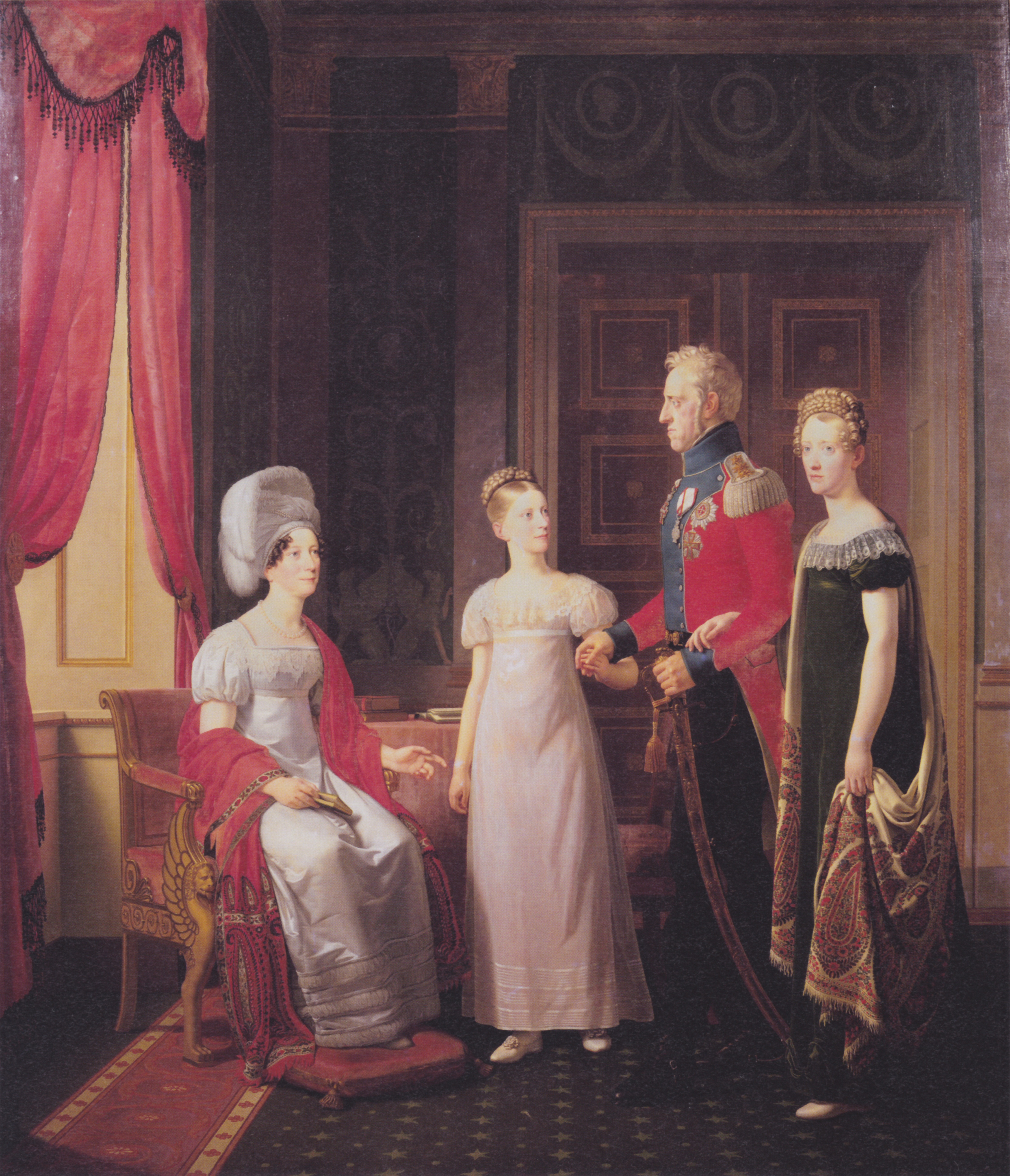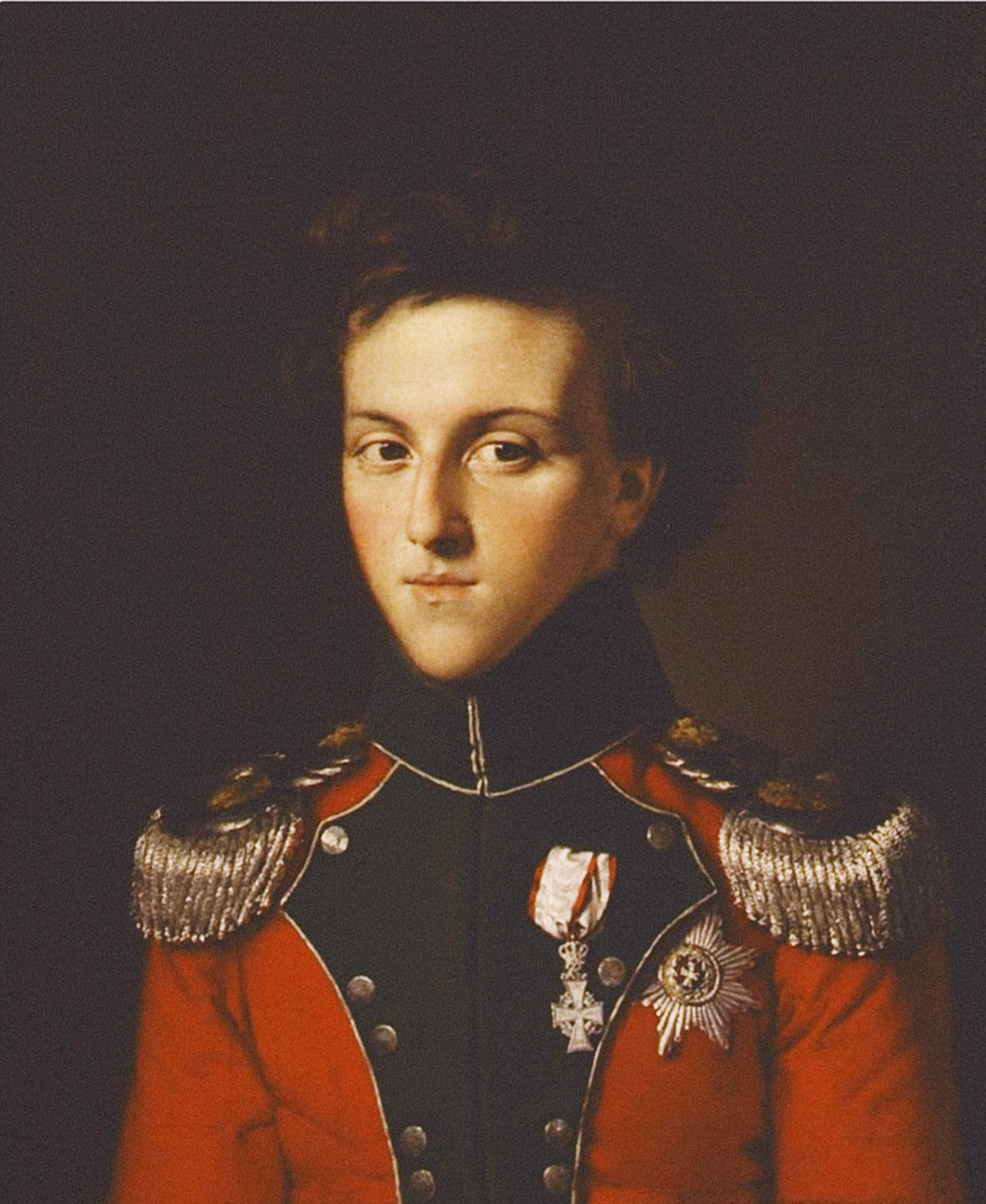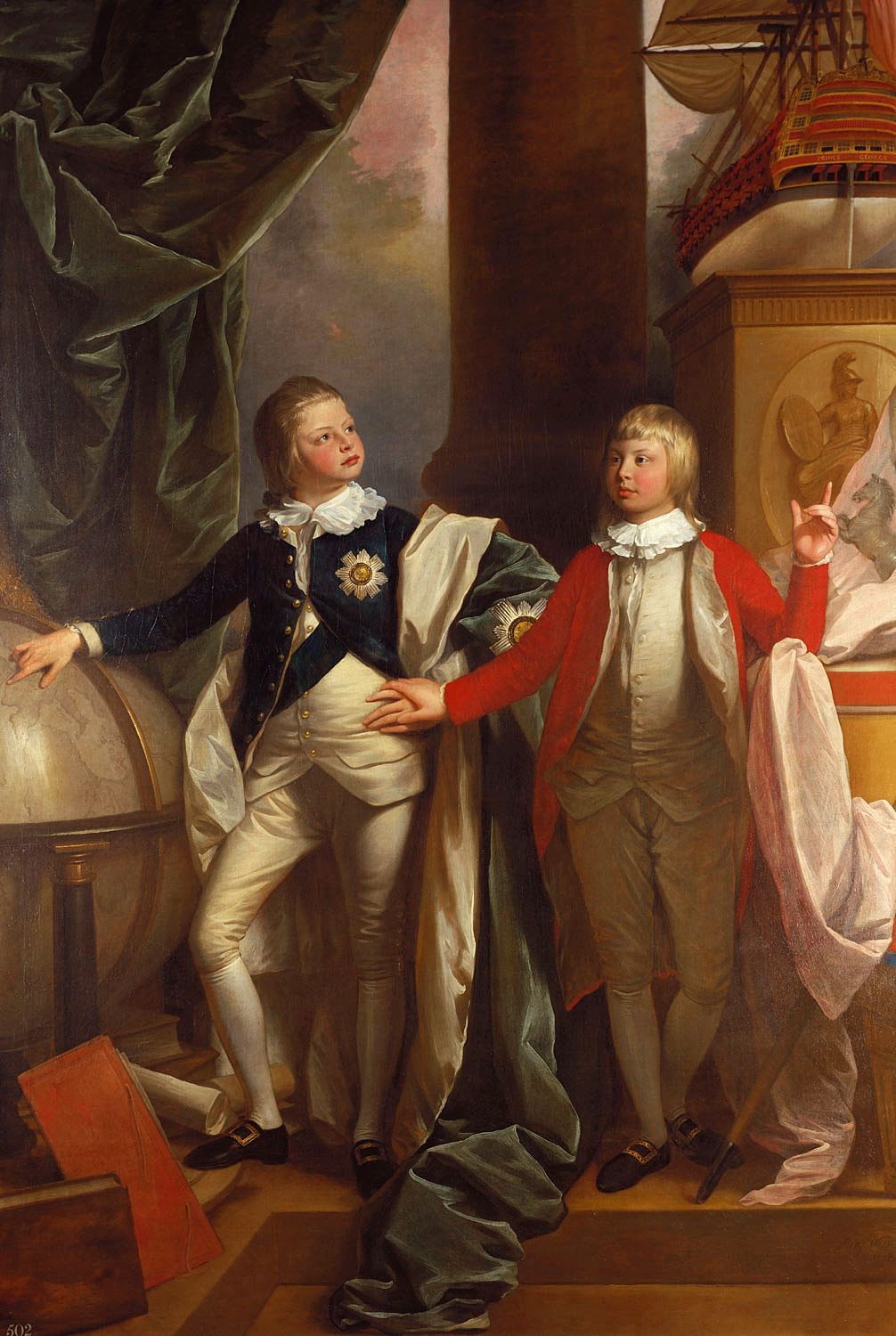|
Caroline Of Denmark
Princess Caroline of Denmark (28 October 1793 – 31 March 1881), was the eldest surviving daughter of King Frederick VI of Denmark. She was unofficially known as "Kronprinsesse Caroline" (English: Crown Princess Caroline) prior to her marriage, and later as "Arveprinsesse Caroline" (English: Hereditary Princess Caroline). She married her father's first cousin, Hereditary Prince Ferdinand, who was heir presumptive to the throne from 1848 to 1863. Early life Princess Caroline was born at Christiansborg Palace in Copenhagen on 28 October 1793. Her parents were Crown Prince Frederick (the future King Frederick VI of Denmark) and his spouse and first cousin, Princess Marie of Hesse-Kassel. Her paternal grandfather King Christian VII being mentally unstable, her father had acted as regent since 1784. Her birth was much welcomed by the public, as her siblings had died soon after their birth. Four months after her birth, on 26 February 1794, Christiansborg Palace was destroyed b ... [...More Info...] [...Related Items...] OR: [Wikipedia] [Google] [Baidu] |
August Schiøtt
Heinrich August Georg Schiøtt (17 December 1823 – 25 June 1895) was a Danish portrait painter. Biography August Schiøtt was born in Helsingør, Denmark. He was the son of Heinrich Erpecum Schiøtt and Anna Sophie Marie Fleron. His father was a customs official. After his confirmation, he was sent to school in Copenhagen where he later entered the Royal Danish Academy of Fine Arts and had an undistinguished academic record. For a short time, he was a private student of Christoffer Wilhelm Eckersberg. His first portrait (of a child) was created in 1844, two years before his graduation. After that, he painted six to eight portraits every year. Altogether, he presented over 150 portraits at the Charlottenborg Spring Exhibition, including several of the Royal Family: Caroline Amalie of Augustenburg (three times), Ferdinand, Hereditary Prince of Denmark, Prince Ferdinand, Princess Caroline of Denmark, Princess Caroline and Prince (later King) Christian IX of Denmark, Christian. I ... [...More Info...] [...Related Items...] OR: [Wikipedia] [Google] [Baidu] |
Salic Law
The Salic law ( or ; la, Lex salica), also called the was the ancient Franks, Frankish Civil law (legal system), civil law code compiled around AD 500 by the first Frankish King, Clovis I, Clovis. The written text is in Latin and contains some of the earliest known instances of Old Dutch. It remained the basis of Frankish law throughout the early Medieval period, and influenced future Western law#History, European legal systems. The best-known tenet of the old law is the principle of exclusion of women from inheritance of thrones, fiefs, and other property. The Salic laws were arbitrated by a committee appointed and empowered by the King of the Franks. Dozens of manuscripts dating from the sixth to eighth centuries and three emendations as late as the ninth century have survived. Salic law provided written codification of both civil law, such as the statutes governing inheritance, and criminal law, such as the punishment for murder. Although it was originally intended as the la ... [...More Info...] [...Related Items...] OR: [Wikipedia] [Google] [Baidu] |
Frederick VII Of Denmark
Frederick VII (Frederik Carl Christian; 6 October 1808 – 15 November 1863) was King of Denmark from 1848 to 1863. He was the last Danish monarch of the older Royal branch of the House of Oldenburg and the last king of Denmark to rule as an absolute monarch. During his reign, he signed a constitution that established a Danish parliament and made the country a constitutional monarchy. Frederick's motto was ''Folkets Kærlighed, min Styrke'' ( Danish for ''the People's Love, my Strength''). Family Frederick was born at Amalienborg Palace to Christian VIII of Denmark and Duchess Charlotte Frederica of Mecklenburg-Schwerin. His maternal grandparents were Friedrich Franz I, Grand Duke of Mecklenburg-Schwerin, and Luise, Duchess of Saxe-Gotha. Marriages The king's first two marriages both ended in scandal and divorce. He was first married in Copenhagen on 1 November 1828 to his second cousin Princess Vilhelmine Marie of Denmark, a daughter of King Frederick VI of Denmar ... [...More Info...] [...Related Items...] OR: [Wikipedia] [Google] [Baidu] |
Christian VIII Of Denmark
Christian VIII (18 September 1786 – 20 January 1848) was King of Denmark from 1839 to 1848 and, as Christian Frederick, King of Norway in 1814. Christian Frederick was the eldest son of Hereditary Prince Frederick, a younger son of King Frederick V of Denmark and Norway. As his cousin, King Frederick VI had no sons, Christian Frederick was heir presumptive to the throne from 1808. Early years Birth and family Prince Christian Frederick of Denmark and Norway was born on 18 September 1786 at Christiansborg Palace, the principal residence of the Danish Monarchy on the island of Slotsholmen in central Copenhagen. He was officially the eldest son of Hereditary Prince Frederick of Denmark and Norway and Duchess Sophia Frederica of Mecklenburg-Schwerin. His father was a younger son of the deceased King Frederick V of Denmark-Norway and his second wife, Duchess Juliana Maria of Brunswick-Wolfenbüttel, and his mother was a daughter of Duke Louis of Mecklenburg-Schwerin. In the ... [...More Info...] [...Related Items...] OR: [Wikipedia] [Google] [Baidu] |
Bernstorff Slot Feb06
Bernstorff is an old and distinguished German-Danish noble family of Mecklenburgian origin. Members of the family held the title of Count/Countess, granted to them on 14.12.1767 by King Christian VII of Denmark. Notable members * Andreas Gottlieb von Bernstorff (1649–1726), Hanoverian minister who accompanied George I to Britain when he became King * Johann Hartwig Ernst von Bernstorff (1712–1772), Danish statesman * Andreas Peter Bernstorff (1735–1797), Danish state minister * Christian Günther von Bernstorff (1769–1835), Danish and Prussian statesman * Joachim Frederik Bernstorff (1771–1835), Danish statesman * Albrecht von Bernstorff (1809–1873), diplomat, Prussian Foreign Minister (1861–1862) * Andreas Bernstorff (1811–1864), Danish military officer * Berthold von Bernstorff (1842–1917), German politician and owner of Schiermonnikoog * Percy von Bernstorff (1858–1930), German public official * Johann Heinrich von Bernstorff (1862–1939), German di ... [...More Info...] [...Related Items...] OR: [Wikipedia] [Google] [Baidu] |
Vallø Stift
Vallø stift or ''Det Adelige Stift Vallø for ugifte døtre'' (Noble Vallø Foundation for Unmarried Daughters) was a Danish foundation for the support of unmarried female nobles. It was located at Vallø Castle just south of Køge on the east coast of the island of Zealand. History Vallø Stift Foundation (''Stiftelsen Vallø Stift'') was created in 1737 by Queen Sophie Magdalene (1700-1770). The convent was inaugurated the following year. It functioned as a convent for unmarried women from noble or princely houses, who resided at Vallø Castle Vallø Castle ( da, Vallø Slot) is a manor house located 7 km south of Køge, in Stevns Municipality, on the island of Zealand in Denmark. It now serves as a residence for Vallø stift, a home for unmarried, widowed and divorced women o .... For this purpose, Vallø Castle was expanded between 1736-38 with a new baroque-style building designed by architect Lauritz de Thurah (1706–1759). Until 1810, the convent w ... [...More Info...] [...Related Items...] OR: [Wikipedia] [Google] [Baidu] |
Aarhus
Aarhus (, , ; officially spelled Århus from 1948 until 1 January 2011) is the second-largest city in Denmark and the seat of Aarhus Municipality. It is located on the eastern shore of Jutland in the Kattegat sea and approximately northwest of Copenhagen. The largest city in Jutland, Aarhus anchors the Central Denmark Region and the statistical region ' (''LØ'') (lit.: Province East Jutland). The LØ is the second most populous statistical region in Denmark with an estimated population of 903,974 (). Aarhus Municipality defines the greater Aarhus area as itself and eight adjacent municipalities totalling 952,824 inhabitants () which is roughly analogous to the municipal and commercial collaboration Business Region Aarhus. The city proper, with an estimated population of 285,273 inhabitants (), ranks as the 2nd-largest city in Denmark. Aarhus dates back to at least the late 8th century and is among the oldest cities in Denmark. It was founded as a harbour settlement at ... [...More Info...] [...Related Items...] OR: [Wikipedia] [Google] [Baidu] |
Sjælland
Zealand ( da, Sjælland ) at 7,031 km2 is the largest and most populous island in Denmark proper (thus excluding Greenland and Disko Island, which are larger in size). Zealand had a population of 2,319,705 on 1 January 2020. It is the 13th-largest island in Europe by area and the 4th most populous. It is connected to Sprogø and Funen by the Great Belt Fixed Link and to Amager by several bridges in Copenhagen. Indirectly, through the island of Amager and the Øresund Bridge, it is also linked to Scania in Sweden. In the south, the Storstrøm Bridge and the Farø Bridges connect it to Falster, and beyond that island to Lolland, from where the Fehmarnbelt Tunnel to Germany is planned. Copenhagen, the capital of Denmark, with a population between 1.3 and 1.4 million people in 2020, is located mostly on the eastern shore of Zealand and partly on the island of Amager. Other cities on Zealand include Roskilde, Hillerød, Næstved, Helsingør, Slagelse, Køge, Holbæ ... [...More Info...] [...Related Items...] OR: [Wikipedia] [Google] [Baidu] |
Nørrejylland
Northern Jutland ( da, Nørrejylland) is a historical region in Denmark, defined as Jutland north of the Kongeå (with the region south of the Kongeå called Southern Jutland (''Sønderjylland'')). As with other historical regions of Denmark, Northern Jutland had its own ting assembly in the Middle Ages, seated in Viborg. Today, Northern Jutland is covered by the regions of North Jutland and Central Jutland (except for Samsø), and the northern parts of the Region of Southern Denmark. Notes : Samsø was historically grouped with Zealand, and was thus not included in Northern Jutland. Samsø was moved into the new Aarhus County in 1970, and that county was merged with neighboring areas to become the Central Jutland region in 2007. For this reason, everything in Central Jutland except for Samsø is part of the historical Northern Jutland. References Geography of Denmark Jutland Regions of Denmark {{Denmark-geo-stub ... [...More Info...] [...Related Items...] OR: [Wikipedia] [Google] [Baidu] |
Prince Christian Of Hesse
Prince Christian of Hesse ( da, Christian af Hessen; german: Christian von Hessen) (14 August 1776 – 14 November 1814) was a German prince and member of the House of Hesse-Kassel. As a son of the Danish Field Marshal Prince Charles of Hesse-Kassel and Princess Louise of Denmark, he was a member of the extended Danish Royal Family and spent his entire life in Denmark. Early life Prince Christian was born at Gottorp Castle, Schleswig as the third son of Prince Charles of Hesse-Kassel, royal governor of the twin duchies of Schleswig and Holstein, and Princess Louise of Denmark, herself a daughter of King Frederick V of Denmark. As a member of the extended Danish Royal Family, Christian was destined for a military career in Denmark from a young age. He was appointed Colonel in 1783, Major General in 1789 and in 1790 Commander of a Regiment. In 1803 he was appointed knight of the Order of the Elephant. In 1805 he was put in charge of a cavalry brigade in Holstein, an ... [...More Info...] [...Related Items...] OR: [Wikipedia] [Google] [Baidu] |
William IV
William IV (William Henry; 21 August 1765 – 20 June 1837) was King of the United Kingdom of Great Britain and Ireland and King of Hanover from 26 June 1830 until his death in 1837. The third son of George III, William succeeded his elder brother George IV, becoming the last king and penultimate monarch of Britain's House of Hanover. William served in the Royal Navy in his youth, spending time in North America and the Caribbean, and was later nicknamed the "Sailor King". In 1789, he was created Duke of Clarence and St Andrews. In 1827, he was appointed Britain's first Lord High Admiral since 1709. As his two elder brothers died without leaving legitimate issue, he inherited the throne when he was 64 years old. His reign saw several reforms: the Poor Law was updated, child labour restricted, slavery abolished in nearly all of the British Empire, and the electoral system refashioned by the Reform Acts of 1832. Although William did not engage in politics ... [...More Info...] [...Related Items...] OR: [Wikipedia] [Google] [Baidu] |








